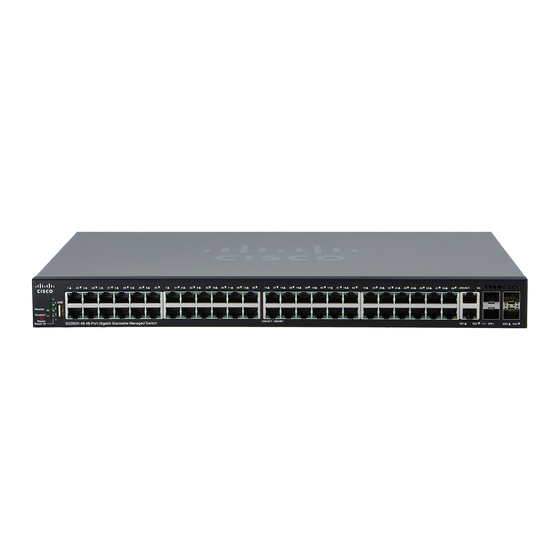Advertisement
Quick Links
Configure Stack Settings on an SG350X
Switch
Objective
This article provides instructions on how to configure stack settings on your switch. Stacked
switches are then collectively managed as a single logical device. In some cases, stack ports
can become members in a stack of Link Aggregation Groups (LAGs) increasing the
bandwidth of the stack interfaces.
For further details on stacking,
Applicable Devices
SG350X Series
Software Version
2.2.5.68
Configure Stack Settings on a Switch
Connect the Switches
Step 1. Determine the stack that you would like to configure. The options are:
Chain — Each unit is connected to the neighboring unit, but there is no cable connection
between the first and last unit. The image below shows a chain topology of a four-unit stack:
click here to view the article - What is Stacking?
Advertisement

Summary of Contents for Cisco SG350X
- Page 1 Configure Stack Settings on an SG350X Switch Objective This article provides instructions on how to configure stack settings on your switch. Stacked switches are then collectively managed as a single logical device. In some cases, stack ports can become members in a stack of Link Aggregation Groups (LAGs) increasing the bandwidth of the stack interfaces.
- Page 2 Ring — Each unit is connected to the neighboring unit. The last unit is connected to the first unit. The image below shows a ring topology of a four-unit stack:...
- Page 3 Step 2. Connect one end of a Small Form-Factor Pluggable (SFP) into the SFP+, XG3, or XG4 port of your switch. Note: In this example, the cable is connected to XG3 port of the switch. It is also possible to stack switches using conventional Ethernet cables on the XG1 and XG2 ports.
- Page 4 Step 3. Connect the other end of the SFP+ cable into the SFP+, XG3 or XG4 port of your switch. Note: In this example, the cable is connected to XG3 port of the switch. Step 4. Repeat Steps 2 to 3 to the remaining switches. You should now have connected your switches according to your desired topology.
- Page 5 Note: Alternatively, you can click the Manage Stack option under Initial Setup in the Getting Started page. Step 2. Click an option for the Stack Mode. The options are: Native Stacking — The switch is part of a stack in which all of the units are of the same type. Hybrid Stacking —...
- Page 6 Note: In this example, Hybrid Stacking is chosen. The Stack Topology displays whether the topology of the stack is chain or ring. In this example, the topology is Chain. The Stack Master displays the unit ID of the master unit of the stack. In this example, the switch being configured (Unit 1) is the master of the stack.
- Page 7 Step 6. Once prompted by the popup message, click OK. The settings are copied to the running configuration file and the stack is rebooted. Step 7. Log in to the web-based utility of your switch. Note: You will be required to configure new password for better protection of your network. Step 8.
- Page 8 Step 9. Enter the new password in the New Password and Confirm Password fields. Step 10. (Optional) Check the Disable Password Complexity Enforcement check box to bypass the password strength requirements. Note: To learn how to configure the Password Strength security feature of the switch, click here for instructions.
- Page 9 You should now have configured the stack settings of your Master unit. Configure Stack Settings on the Backup or Slave Switch Step 1. Log in to the web-based utility of your switch then choose Administration > Stack Management. Note: Alternatively, you can click the Manage Stack option under Initial Setup in the Getting Started page.
- Page 10 Step 2. Click an option for the Stack Mode. The options are: Native Stacking — The switch is part of a stack in which all of the units are of the same type. Hybrid Stacking — The switch is part of a stack that can consist of either mixed types of Sx350 devices or mixed types of Sx550 devices, but not a mix of Sx350 and Sx550 devices.
- Page 11 Note: In this example, XG3 and XG4 are chosen. Step 4. Choose a unit ID from the drop-down list or choose Auto to have the unit ID be assigned by the system. Note: In this example, Auto is chosen. The Unit x Stack Connection Speed displays the speed of the stack connection. Step 5.
- Page 12 The switch will reboot and apply the configuration settings. Step 7. Log in to the web-based utility of your Master switch then choose Administration > Stack Management. The Stack Management page of the Master switch should display the configured switch. Step 8.
- Page 13 Step 9. Repeat Steps 1 to 8 to configure the slave units. You should now have configured the stack settings on your switches. View a video related to this article... Click here to view other Tech Talks from Cisco...















